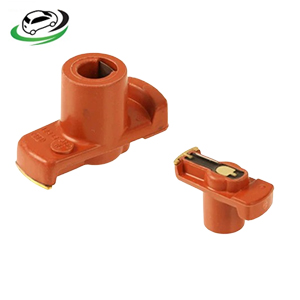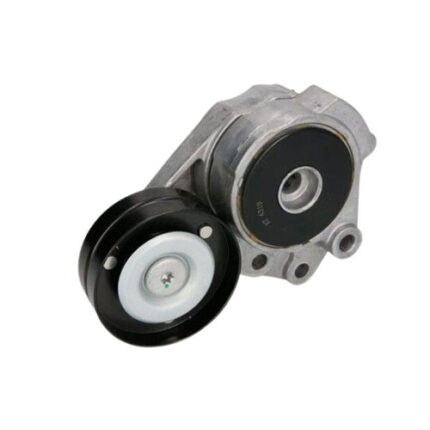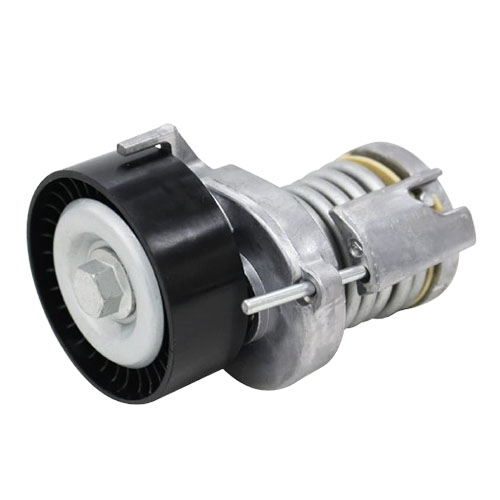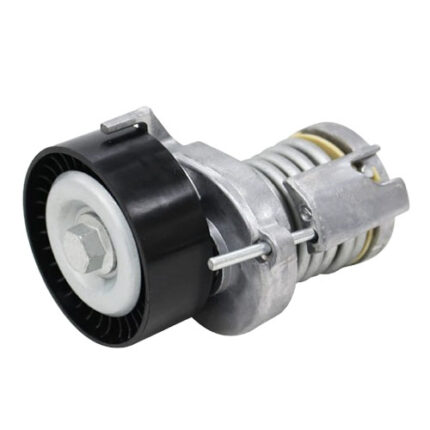Get AUDI A2 1.4/1.6 FSI V-ribbed Belt Tensioner Pulley 030145299F in Kenya
The V-ribbed belt tensioner pulley is a crucial component in modern automotive engines, playing a vital role in maintaining proper tension on the serpentine belt or V-ribbed belt. This belt drives various engine accessories, such as the alternator, power steering pump, water pump, and air conditioning compressor. The tensioner pulley ensures that the belt remains taut, preventing slippage and ensuring that these accessories operate efficiently. This guide explores the function, construction, types, symptoms of failure, maintenance, and replacement of the V-ribbed belt tensioner pulley.
What is a V-Ribbed Belt Tensioner Pulley?
A V-ribbed belt tensioner pulley, commonly known as a serpentine belt tensioner pulley, is part of the belt tensioner assembly in an internal combustion engine. The tensioner pulley is designed to apply the correct amount of tension to the V-ribbed belt, which is responsible for driving multiple engine accessories. The tensioner pulley works in conjunction with the tensioner arm and a spring mechanism to maintain consistent tension on the belt, regardless of engine speed or load.
Functions of the V-Ribbed Belt Tensioner Pulley
The V-ribbed belt tensioner pulley performs several essential functions in the engine’s accessory drive system:
- Maintaining Belt Tension: The primary function of the tensioner pulley is to maintain proper tension on the V-ribbed belt. This tension is crucial for preventing belt slippage, ensuring that the belt drives the engine accessories effectively.
- Absorbing Vibrations: The tensioner pulley helps absorb vibrations and fluctuations in the belt’s tension caused by the operation of the engine and its accessories. This reduces wear on the belt and other components, extending their lifespan.
- Ensuring Proper Belt Alignment: The tensioner pulley keeps the V-ribbed belt aligned on the pulleys of the engine accessories. Proper alignment is essential for preventing the belt from jumping off the pulleys or becoming damaged.
- Compensating for Belt Wear: As the V-ribbed belt wears over time, it may stretch slightly. The tensioner pulley compensates for this stretching by adjusting the tension, ensuring that the belt continues to operate efficiently.
- Supporting Accessory Operation: By maintaining proper tension on the belt, the tensioner pulley ensures that engine accessories such as the alternator, water pump, and air conditioning compressor receive the power they need to function correctly.
Construction of the V-Ribbed Belt Tensioner Pulley
The V-ribbed belt tensioner pulley is a relatively simple yet durable component designed to withstand the harsh conditions of the engine bay. It consists of several key parts:
- Pulley Wheel: The pulley wheel is the main component that comes into contact with the V-ribbed belt. It is typically made from steel or high-strength plastic and is designed to resist wear and tear.
- Bearing: The pulley wheel rotates on a bearing, which is usually sealed to prevent dirt, debris, and moisture from entering. The bearing ensures smooth and consistent rotation of the pulley.
- Tensioner Arm: The tensioner pulley is mounted on a tensioner arm, which is connected to a spring mechanism. The arm and spring work together to apply the correct amount of tension to the belt.
- Spring Mechanism: The spring mechanism, usually a coil spring, provides the force needed to maintain tension on the belt. It allows the tensioner arm to move slightly to compensate for changes in belt tension.
- Mounting Bracket: The entire tensioner assembly, including the pulley, arm, and spring, is mounted to the engine using a bracket. This bracket is typically made of metal and is securely fastened to the engine block or another sturdy component.
Types of V-Ribbed Belt Tensioner Pulleys
There are several types of V-ribbed belt tensioner pulleys, each designed for specific applications and engine configurations:
- Automatic Tensioner Pulleys: Automatic tensioner pulleys are the most common type used in modern vehicles. They automatically adjust the tension on the V-ribbed belt using a spring mechanism. These pulleys require little maintenance and are designed to provide consistent tension throughout the life of the belt.
- Manual Tensioner Pulleys: Manual tensioner pulleys are adjusted manually using a bolt or screw. They are less common in modern vehicles and are typically found in older or specialized engines. Manual tensioners require periodic adjustment to maintain proper belt tension.
- Hydraulic Tensioner Pulleys: Hydraulic tensioner pulleys use hydraulic fluid to apply tension to the V-ribbed belt. These pulleys are often used in high-performance or heavy-duty engines, where precise tension control is essential.
- Idler Pulleys: While not technically tensioner pulleys, idler pulleys serve a similar function by guiding the V-ribbed belt and maintaining proper alignment. Idler pulleys do not apply tension but help ensure the belt runs smoothly over the accessory pulleys.
Symptoms of a Failing V-Ribbed Belt Tensioner Pulley
A failing V-ribbed belt tensioner pulley can lead to various symptoms that affect engine performance and reliability. Common signs of a faulty tensioner pulley include:
- Squealing or Chirping Noises: One of the most common symptoms of a failing tensioner pulley is a squealing or chirping noise coming from the engine bay. This noise is often caused by a worn or misaligned pulley, which causes the belt to slip.
- Belt Slippage: If the tensioner pulley fails to maintain proper tension on the belt, the belt may slip on the accessory pulleys. This can lead to reduced performance of engine accessories, such as a weak alternator output or poor air conditioning performance.
- Visible Wear on the Belt: A worn or damaged tensioner pulley can cause uneven wear on the V-ribbed belt. You may notice fraying, cracking, or glazing on the belt surface, indicating that the tensioner pulley is not functioning correctly.
- Vibrations or Oscillations: A failing tensioner pulley may cause the belt to vibrate or oscillate excessively. This can lead to increased wear on the belt and other components and may cause the belt to jump off the pulleys.
- Engine Overheating: In severe cases, a failing tensioner pulley can cause the belt to lose tension or slip off entirely, leading to a loss of operation in critical accessories such as the water pump. This can result in engine overheating.
- Check Engine Light: In some cases, a faulty tensioner pulley can trigger the check engine light if the belt slip affects the operation of engine sensors or accessories.
Consequences of Ignoring a Failing Tensioner Pulley
Neglecting to address a failing V-ribbed belt tensioner pulley can lead to several serious consequences:
- Belt Failure: If the tensioner pulley fails to maintain proper tension, the V-ribbed belt may eventually break or slip off the pulleys. This can cause a sudden loss of power to critical engine accessories, such as the alternator, power steering pump, or water pump.
- Engine Overheating: A broken or slipped belt can lead to the failure of the water pump, resulting in engine overheating. Overheating can cause significant engine damage, including a blown head gasket or warped cylinder head.
- Loss of Power Steering: In vehicles with hydraulic power steering, a broken or slipped belt can cause a loss of power steering assistance, making the vehicle difficult to steer.
- Increased Repair Costs: Ignoring a failing tensioner pulley can lead to more extensive damage to the engine and accessory drive system. This can result in costly repairs and extended downtime.
Maintaining and Replacing the V-Ribbed Belt Tensioner Pulley
Proper maintenance and timely replacement of the V-ribbed belt tensioner pulley are essential for ensuring reliable engine performance and preventing potential issues. Here are the general steps for maintaining and replacing a tensioner pulley:
- Regular Inspections: Periodically inspect the tensioner pulley for signs of wear, such as excessive play, noise, or roughness when rotated. Check the condition of the V-ribbed belt for any signs of damage or wear.
- Replace Worn Components: If the tensioner pulley shows signs of wear or damage, it should be replaced immediately. Replacing the tensioner pulley at the same time as the V-ribbed belt is a good practice to ensure optimal performance.
- Clean the Pulleys: When replacing the tensioner pulley, it is also a good idea to clean the other pulleys in the accessory drive system. This helps ensure proper belt alignment and reduces the risk of premature belt wear.
- Install the New Tensioner Pulley: To replace the tensioner pulley, first, relieve the tension on the V-ribbed belt by rotating the tensioner arm. Remove the old pulley and install the new one, ensuring that it is properly aligned and securely fastened.
- Reinstall the Belt: After replacing the tensioner pulley, reinstall the V-ribbed belt according to the manufacturer’s belt routing diagram. Ensure that the belt is properly seated on all pulleys and that the tensioner applies the correct amount of tension.
- Test the Engine: Start the engine and observe the operation of the tensioner pulley and V-ribbed belt. Listen for any unusual noises and check for smooth belt operation. Make sure the belt tension is correct and that the engine accessories are functioning properly.
Choosing the Right V-Ribbed Belt Tensioner Pulley
When selecting a V-ribbed belt tensioner pulley, it is important to choose a high-quality part that matches your vehicle’s specifications:
- OEM Parts: Original Equipment Manufacturer (OEM) tensioner pulleys are designed to meet the exact specifications of your vehicle. They offer reliable performance and compatibility with your engine.
- Aftermarket Parts: Aftermarket tensioner pulleys can vary in quality, so it is important to choose a reputable brand. Look for tensioner pulleys that have been tested for durability and performance.
- Performance Tensioner Pulleys: For high-performance or heavy-duty engines, consider upgrading to a performance tensioner pulley. These pulleys are designed to handle higher loads and provide more precise tension control.
- Compatibility: Ensure that the tensioner pulley you choose is compatible with your vehicle’s make, model, and engine configuration. Verify the part number and specifications before making a purchase.
Follow us on Facebook for more parts.




